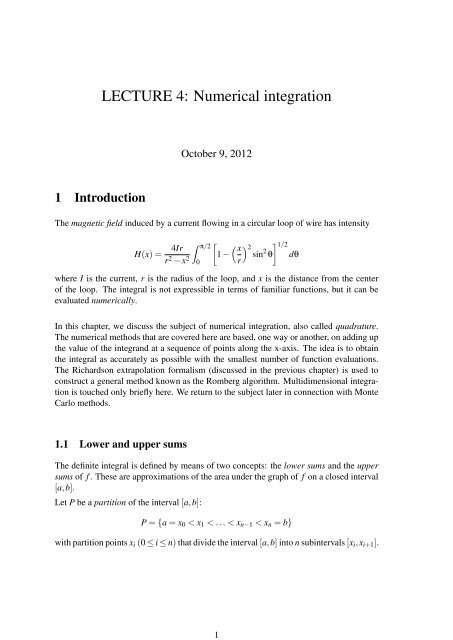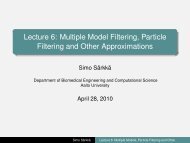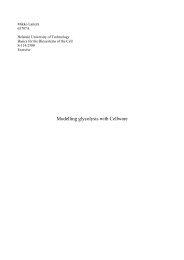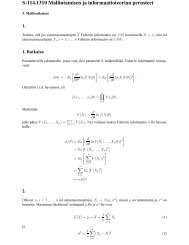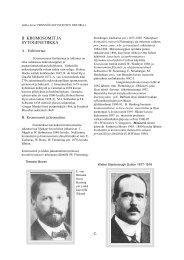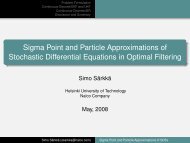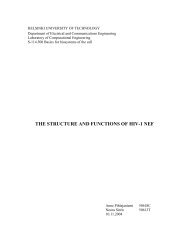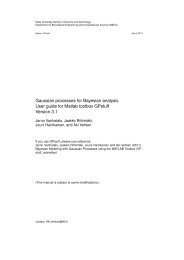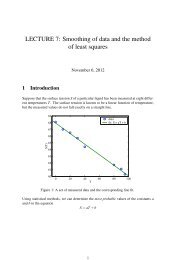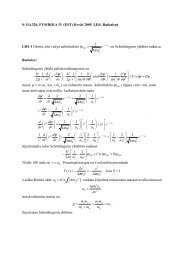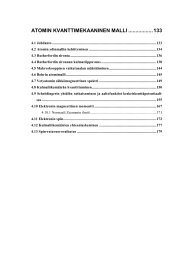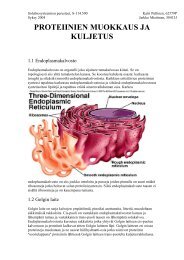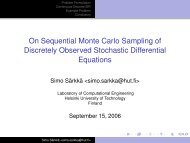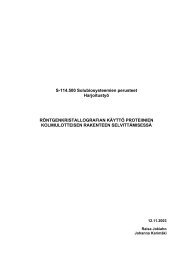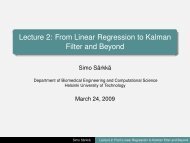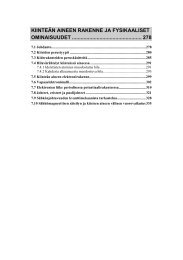LECTURE 4: Numerical integration
LECTURE 4: Numerical integration
LECTURE 4: Numerical integration
Create successful ePaper yourself
Turn your PDF publications into a flip-book with our unique Google optimized e-Paper software.
1<br />
<strong>LECTURE</strong> 4: <strong>Numerical</strong> <strong>integration</strong><br />
October 9, 2012<br />
1 Introduction<br />
The magnetic field induced by a current flowing in a circular loop of wire has intensity<br />
H(x) =<br />
4Ir ∫ π/2<br />
[ ( x<br />
) ] 2 1/2<br />
r 2 − x 2 1 − sin 2 θ dθ<br />
0 r<br />
where I is the current, r is the radius of the loop, and x is the distance from the center<br />
of the loop. The integral is not expressible in terms of familiar functions, but it can be<br />
evaluated numerically.<br />
In this chapter, we discuss the subject of numerical <strong>integration</strong>, also called quadrature.<br />
The numerical methods that are covered here are based, one way or another, on adding up<br />
the value of the integrand at a sequence of points along the x-axis. The idea is to obtain<br />
the integral as accurately as possible with the smallest number of function evaluations.<br />
The Richardson extrapolation formalism (discussed in the previous chapter) is used to<br />
construct a general method known as the Romberg algorithm. Multidimensional <strong>integration</strong><br />
is touched only briefly here. We return to the subject later in connection with Monte<br />
Carlo methods.<br />
1.1 Lower and upper sums<br />
The definite integral is defined by means of two concepts: the lower sums and the upper<br />
sums of f . These are approximations of the area under the graph of f on a closed interval<br />
[a,b].<br />
Let P be a partition of the interval [a,b]:<br />
P = {a = x 0 < x 1 < ... < x n−1 < x n = b}<br />
with partition points x i (0 ≤ i ≤ n) that divide the interval [a,b] into n subintervals [x i ,x i+1 ].
2<br />
Denote by m i the greatest lower bound (infimum) of f (x) on [x i ,x i+1 ]:<br />
m i = inf{ f (x) : x i ≤ x ≤ x i+1 }<br />
Likewise, denote by M i the least upper bound (supremum) of f (x) on [x i ,x i+1 ]:<br />
M i = sup{ f (x) : x i ≤ x ≤ x i+1 }<br />
The lower sums and upper sums of f corresponding to a given partition P are defined to<br />
be<br />
L( f ;P) =<br />
U( f ;P) =<br />
n−1<br />
∑<br />
i=0<br />
m i (x i+1 − x i )<br />
n−1<br />
∑ M i (x i+1 − x i )<br />
i=0<br />
If f is positive, then these two quantities can be interpreted as estimates of the area under<br />
the curve for f .<br />
a=x0 x1 x2 x3 x4 x5 x6 x7 x8=b<br />
Figure 1: Lower sums.<br />
a=x0 x1 x2 x3 x4 x5 x6 x7 x8=b<br />
Figure 2: Upper sums.
3<br />
1.2 Riemann-integrable functions<br />
Consider the least upper bound obtained when P is allowed to range over all partitions of<br />
the interval [a,b]. This is abbreviated sup P L( f ;P). Similarly, the greatest lower bound,<br />
when P ranges over all partitions P on [a,b], is abbreviated inf P L( f ;P).<br />
If these two numbers are the same,<br />
sup<br />
P<br />
then f is Riemann integrable on [a,b].<br />
L( f ;P) = infL( f ;P)<br />
P<br />
Theorem. Every continuous function defined on a closed interval of the real line is Riemann<br />
integrable.<br />
The Riemann integral of a continuous function on [a,b] can be obtained by two limits:<br />
lim sup<br />
n→∞ P<br />
L( f ;P n ) =<br />
∫ b<br />
a<br />
f (x)dx = lim<br />
n→∞<br />
inf<br />
P L( f ;P n)<br />
Here the length of the largest subinterval in P n converges to zero as n → ∞.<br />
Direct translation of this definition into a numerical algorithm is possible, but the resulting<br />
algorithm converges very slowly. The situation can be improved dramatically by using<br />
more sophisticated methods such as the Romberg’s algorithm.
4<br />
2 Trapezoid rule<br />
The trapezoid method is based on an estimation of the area under a curve using trapezoids.<br />
First the interval [a,b] is divided into subintervals according to the partition P =<br />
{a = x 0 < x 1 < ... < x n−1 < x n = b}.<br />
A typical trapezoid has the subinterval [x i ,x i+1 ] as its base, and the two vertical sides are<br />
f (x i ) and f (x i+1 ). The area is equal to the base times the average height. Thus we obtain<br />
the basic trapezoid rule:<br />
∫ xi+1<br />
x i<br />
f (x)dx ≈ A i = 1 2 (x i+1 − x i )[ f (x i ) + f (x i+1 )]<br />
The total area under all of the trapezoids is given by the composite trapezoid rule:<br />
∫ b<br />
a<br />
f (x)dx ≈ T ( f ;P) =<br />
n−1<br />
∑<br />
i=0<br />
A i = 1 2<br />
n−1<br />
∑<br />
i=0<br />
(x i+1 − x i )[ f (x i ) + f (x i+1 )]<br />
f(xi)<br />
f(xi+1)<br />
xi<br />
xi+1<br />
Figure 3: The basic trapezoid rule.<br />
2.1 Uniform spacing<br />
In practice, the trapezoid rule is used with uniform partition of the interval. The division<br />
points x i are equally spaced: x i = a + ih, where h = (b − a)/n and 0 ≤ i ≤ n. This gives a<br />
simpler formula<br />
∫ b<br />
a<br />
f (x)dx ≈ T ( f ;P) = h 2<br />
n−1<br />
∑<br />
i=0<br />
[ f (x i ) + f (x i+1 )]<br />
A computationally preferable form is written as<br />
{ }<br />
∫ b<br />
n−1<br />
f (x)dx ≈ T ( f ;P) = h ∑ f (x i ) + 1<br />
a<br />
i=1<br />
2 [ f (x 0) + f (x n )]
5<br />
Implementation<br />
The following procedure Trapezoid uses the trapezoid method with uniform spacing to<br />
estimate the definite integral of a function f on a closed interval [a,b].<br />
double Trapezoid(double (*f)(double x),<br />
double a, double b, int n)<br />
{<br />
int i;<br />
double h, result;<br />
h = (b-a)/(double)n;<br />
result = 0.5*(f(a)+f(b));<br />
for(i=1; i
6<br />
2.2 Error analysis<br />
Theorem on precision of trapezoid rule.<br />
If f ′′ exists and is continuous on the interval [a,b], and if the composite trapezoid rule T<br />
with uniform spacing h is used to estimate the integral I = ∫ b<br />
a f (x)dx, then for some ξ in<br />
(a,b),<br />
I − T = − 1<br />
12 (b − a)h2 f ′′ (ξ) = O(h 2 )<br />
To prove this use the error formula for polynomial interpolation with n = 1, x 0 = 0, and<br />
x 1 = 1: f (x)− p(x) = 1<br />
(n+1)! f (n+1) (ξ)∏ n i=0 (x−x i) plus mean-value theorem ∫ b<br />
a f (x)g(x)dx =<br />
f (ξ) ∫ b<br />
a g(x)dx. Example. If the trapezoid rule is used to compute<br />
I =<br />
∫ 1<br />
0<br />
e −x2 dx<br />
with an error at most 1 2 × 10−4 , how many points should be used?<br />
The error formula is<br />
In this example,<br />
f (x) = e −x2<br />
f ′ (x) = −2xe −x2<br />
f ′′ (x) = (4x 2 − 2)e −x2<br />
I − T = − 1 12 (b − a)h2 f ′′ (ξ)<br />
Thus, | f ′′ (x)| ≤ 2 on the interval [0,1], and<br />
|I − T | ≤ 1 6 h2<br />
To have an error of at most 1 2 × 10−4 , we require that h = (b − a)/n ≤ 0.01732 or n ≥ 58.<br />
Using the procedure Trapezoid with n = 58, we obtain 0.7468059 which is incorrect in<br />
the fifth digit.
7<br />
2.3 Recursive trapezoid formula<br />
We now introduce a formula for the composite trapezoid rule when the interval [a,b] is<br />
subdivided into 2 n equal parts. We have<br />
n−1<br />
T ( f ;P) = h ∑<br />
= h<br />
i=1<br />
n−1<br />
∑<br />
i=1<br />
f (x i ) + h 2 [ f (x 0) + f (x n )]<br />
f (a + ih) + h [ f (a) + f (b)]<br />
2<br />
If we now replace n by 2 n and use h = (b − a)/2 n , the formula becomes<br />
2 n −1<br />
R(n,0) = h ∑ f (a + ih) + h [ f (a) + f (b)]<br />
i=1<br />
2<br />
Here we have introduced the notation R(n,0) which is used in the next section in connection<br />
with the Romberg algorithm. The notation R(n,0) denotes the result of applying the<br />
composite trapezoid rule with 2 n equal subintervals.<br />
SUBINTERVALS<br />
0<br />
2<br />
2<br />
2<br />
1<br />
2<br />
a<br />
ARRAY<br />
R(0,0)<br />
R(1,0)<br />
R(2,0)<br />
R(3,0)<br />
b<br />
2 3 Figure 5: The recursive trapezoid rule.<br />
For the Romberg algorithm, we need a method for computing R(n,0) from R(n − 1,0)<br />
without unnecessary evaluations of f . We use the identity<br />
R(n,0) = 1 2 R(n − 1,0) + [R(n,0) − 1 R(n − 1,0)]<br />
2<br />
It is desirable to compute the bracketed expression with as little extra computation as<br />
possible. We have<br />
2 n −1<br />
R(n,0) = h ∑ f (a + ih) +C<br />
i=1<br />
2 n−1 −1<br />
R(n − 1,0) = 2h ∑ f (a + 2 jh) + 2C<br />
j=1<br />
where<br />
C = h [ f (a) + f (b)]<br />
2<br />
Notice that the size of the subintervals for R(n − 1,0) are twice the size of those for<br />
R(n,0).
8<br />
By subtraction we get<br />
R(n,0) − 1 2 R(n − 1,0) = h 2 n −1<br />
∑<br />
i=1<br />
2 n−1 −1<br />
f (a + ih) − h ∑ f (a + 2 jh)<br />
j=1<br />
2 n−1<br />
= h ∑ f [a + (2k − 1)h]<br />
k=1<br />
Here we have taken into account that each term in the first sum that corresponds to an even<br />
value of i is canceled by a term in the second sum. This leaves only terms that correspond<br />
to odd values of i.<br />
This gives us the recursive trapezoid formula.<br />
If R(n − 1,0) is available, then R(n,0) can be computed by the formula<br />
R(n,0) = 1 2 n−1<br />
2 R(n − 1,0) + h ∑ f [a + (2k − 1)h] (n ≥ 1)<br />
k=1<br />
using h = (b − a)/2 n and R(0,0) =<br />
2 1 (b − a)[ f (a) + f (b)].<br />
Implementation<br />
The following procedure RecTrapezoid uses the recursive trapezoid formula to calculate<br />
a sequence of approximations to the definite integral of function f on the interval [a,b].<br />
void RecTrapezoid(REAL (*f)(REAL x), REAL a, REAL b,<br />
int n, REAL *R)<br />
{<br />
int i, j, k, kmax=1;<br />
REAL h, sum;<br />
}<br />
h = b-a;<br />
/* Value of R(0,0) */<br />
R[0] = (h/2.0)*(f(a)+f(b));<br />
/* Successive approximations R(n,0) */<br />
for(i=1; i
9<br />
Example.<br />
The procedure RecTrapezoid was used to calculate the value of π by evaluating the integral<br />
π ≈<br />
∫ 1<br />
The following output is obtained with n = 9:<br />
R(0,0) = 3.000000000000<br />
R(1,0) = 3.100000000000<br />
R(2,0) = 3.131176470588<br />
R(3,0) = 3.138988494491<br />
R(4,0) = 3.140941612041<br />
R(5,0) = 3.141429893175<br />
R(6,0) = 3.141551963486<br />
R(7,0) = 3.141582481064<br />
R(8,0) = 3.141590110458<br />
R(9,0) = 3.141592017807<br />
0<br />
4<br />
1 + x 2 dx<br />
The approximation is correct in the sixth decimal. The correct value is 3.141592654 with<br />
nine decimals.<br />
Next, we introduce the Romberg algorithm which uses the numbers R(n,0) and improves<br />
the estimates in a fashion similar to that of Richardson extrapolation.
10<br />
3 Romberg algorithm<br />
3.1 Description<br />
The Romberg algorithm produces a triangular array of numbers, all of which are numerical<br />
estimates of the definite integral ∫ b<br />
a f (x)dx. The array is denoted by<br />
R(0,0)<br />
R(1,0) R(1,1)<br />
R(2,0) R(2,1) R(2,2)<br />
R(3,0) R(3,1) R(3,2) R(3,3)<br />
. . . .<br />
R(n,0) R(n,1) R(n,2) R(n,3) ... R(n,n)<br />
The first column contains estimates R(k,0) obtained by applying the trapezoid rule with<br />
2 k equal subintervals. The first one is obtained using the formula<br />
R(0,0) = 1 (b − a)[ f (a) + f (b)]<br />
2<br />
R(n,0) is obtained easily from R(n − 1,0) using the formula developed in the previous<br />
section:<br />
R(n,0) = 1 2 n−1<br />
2 R(n − 1,0) + h ∑ f [a + (2k − 1)h]<br />
k=1<br />
where h = (b − a)/2 n and n ≥ 1.<br />
The second and successive columns are generated by the following extrapolation formula:<br />
R(n,m) = R(n,m − 1) + 1<br />
4 m [R(n,m − 1) − R(n − 1,m − 1)]<br />
− 1<br />
with n ≥ 1 and m ≥ 1. This formula results from the application of the Richardson extrapolation<br />
theorem.
11<br />
3.2 Derivation of the Romberg algorithm<br />
To briefly sketch where the iterative equation behind Romberg algorithm comes from we<br />
start from the following formula where the error is expressed in the trapezoid rule with<br />
2 n−1 equal subintervals<br />
∫ b<br />
a<br />
f (x)dx = R(n − 1,0) + a 2 h 2 + a 4 h 4 + a 6 h 6 + ...<br />
This is one form of Euler-Maclaurin formula (see the next page). (A proof can be found<br />
for instance in Gregory, R.T, and Kearney, D., A Collection of Matrices for Testing Computational<br />
Algorithms (Wiley, 1969).) Here h = (b − a)/2 n and the coefficients a i depend<br />
on f but not on h. R(n − 1,0) is one of the trapezoidal elements in the Romberg array.<br />
For our purposes, it is not necessary to know the definite expressions for the coefficients.<br />
For the theory to work smoothly, we assume that f possesses derivatives of all orders on<br />
the interval [a,b].<br />
Now recall the theory of Richardson extrapolation. We can use the same procedure here<br />
due to the form of the equation above. Replacing n with n + 1 and h with h/2, we have<br />
∫ b<br />
a<br />
f (x)dx = R(n,0) + 1 4 a 2h 2 + 1<br />
16 a 4h 4 + 1<br />
64 a 6h 6 + ...<br />
Subtracting the first equation from the second equation multiplied by 4 gives<br />
where<br />
∫ b<br />
a<br />
f (x)dx = R(n,1) − 1 4 a 4h 4 − 5<br />
16 a 6h 6 − ...<br />
R(n,1) = R(n,0) + 1 [R(n,0) − R(n − 1,0)] (n ≥ 1)<br />
3<br />
Note that this is the first case (m = 1) of the extrapolation formula that is used to generate<br />
the Romberg array.<br />
The term R(n,1) should be considerably more accurate than R(n,0) or R(n − 1,0) since<br />
the error series is now O(h 4 ). This process can be repeated to further eliminate higher<br />
terms in the error series.<br />
The only assumption made is that the first equation with the error series is valid for the<br />
function f . In practice, we use only a modest number of rows in the Romberg algorithm,<br />
which means that the assumption is likely to be valid. The situation is governed by a<br />
theorem called the Euler-Maclaurin formula.
12<br />
3.3 Euler-Maclaurin formula and error term<br />
Theorem.<br />
If f (2m) exists and is continuous on the interval [a,b], then<br />
∫ b<br />
a<br />
f (x)dx = h 2<br />
n−1<br />
∑<br />
i=0<br />
where h = (b − a)/n, x i = a + ih for 0 ≤ i ≤ n, and<br />
E =<br />
for some ξ in the interval (a,b).<br />
[ f (x i ) + f (x i+1 )] + E<br />
m−1<br />
∑ A 2k h 2k [ f (2k−1) (a) − f (2k−1) (b)] − A 2m (b − a)h 2m f (2m) (ξ)<br />
k=1<br />
In this theorem, the A k ’s are constants and they can be defined by the equation (see<br />
e.g. D.M. Young and R.T. Gregory, A survey of <strong>Numerical</strong> Mathematics, Vol.1, p. 374,<br />
(Dover) for details):<br />
∞<br />
x<br />
e x − 1 = ∑ A k x k<br />
k=0<br />
The points to notice are that the right-hand side of the Euler-Maclaurin formula contains<br />
the trapezoid rule and an error term E. Furthermore, the error term can be expressed as a<br />
finite sum in ascending powers of h 2 .<br />
This theorem gives the formal justification to the Romberg algorithm.
13<br />
3.4 Implementation<br />
The following procedure Romberg uses the extrapolation formula to calculate numerical<br />
estimates of the definite integral ∫ b<br />
a f (x)dx. The input is the function f , the endpoints of<br />
the interval [a,b], the number of iterations n and the Romberg array (R) 0:n×0:n .<br />
void Romberg(double (*f)(double x),<br />
double a, double b, int n,<br />
double R[][MAXN])<br />
{<br />
int i, j, k, kmax=1;<br />
double h, sum;<br />
h = b-a;<br />
R[0][0] = (h/2.0)*(f(a)+f(b));<br />
for(i=1; i
14<br />
Output<br />
Using same example as before, we calculate the value of π by evaluating the integral<br />
(Correct value is 3.141592654.)<br />
π ≈<br />
∫ 1<br />
0<br />
4<br />
1 + x 2 dx<br />
The output using double-precision:<br />
3.0000000000<br />
3.1000000000 3.1333333333<br />
3.1311764706 3.1415686275 3.1421176471<br />
3.1389884945 3.1415925025 3.1415940941 3.1415857838<br />
3.1409416120 3.1415926512 3.1415926611 3.1415926384 3.1415926653<br />
3.1414298932 3.1415926536 3.1415926537 3.1415926536 3.1415926536 3.1415926536<br />
And using single-precision:<br />
3.0000000000<br />
3.0999999046 3.1333332062<br />
3.1311764717 3.1415686607 3.1421177387<br />
3.1389884949 3.1415925026 3.1415941715 3.1415858269<br />
3.1409416199 3.1415927410 3.1415927410 3.1415927410 3.1415927410<br />
3.1414299011 3.1415927410 3.1415927410 3.1415927410 3.1415927410 3.1415927410<br />
We notice that the algorithm converges very quickly (with double precision, n = 5 is<br />
enough to obtain nine decimals of precision). With single precision, the accuracy of the<br />
calculation is limited to six decimals.
15<br />
4 Adaptive Simpson’s scheme<br />
We now proceed to discussing a method known as the Simpson’s rule and develop an<br />
adaptive scheme for obtaining a numerical approximation for the integral ∫ b<br />
a f (x)dx. In<br />
the adaptive algorithm, the partitioning of the interval [a,b] is not selected beforehand but<br />
automatically determined.<br />
4.1 Simpson’s rule<br />
A considerable improvement over the trapezoid rule can be achieved by approximating<br />
the function within each of the n subintervals by some polynomial. When second-order<br />
polynomials are used, the resulting algorithm is called the Simpson’s rule.<br />
Dividing the interval [a,b] into two equal subintervals with partition points a, a + h and<br />
a + 2h = b results in the basic Simpson’s rule:<br />
∫ a+2h<br />
a<br />
f (x)dx ≈ h [ f (a) + 4 f (a + h) + f (a + 2h)]<br />
3<br />
Proof. Approximating the function with a polynomial of degree ≤ 2 we can write ∫ b<br />
a f (x)dx ≈<br />
A f (a) + B f ( a+b<br />
2<br />
) +C f (b), where f (x) is assumed continuous on the interval [a,b]. The<br />
coefficients A, B and C are chosen such that the approximation will give correct values<br />
for the integral when f is aquadratic polynomial. Let a = −1 and b = 1: ∫ 1<br />
−1 f (x)dx ≈<br />
A f (−1) + B f (0) +C f (1). The following equations must hold:<br />
f (x) = 1 : ∫ 1<br />
−1 dx = 2 = A + B +C<br />
f (x) = x : ∫ 1<br />
−1 xdx = 0 = −A +C<br />
f (x) = x 2 : ∫ 1<br />
−1 x 2 dx = 2/3 = A +C<br />
⇒ A = 1/3, B = 4/3, and C = 1/3. ⇒ ∫ 1<br />
−1 f (x)dx ≈ 1 3<br />
[ f (−1) + 4 f (0) + f (1)]. Using<br />
the linear mapping y = (b − a)/2 + (a + b)/2 from [−1,1] to [a,b] we obtain the basic<br />
Simpson’s rule: ∫ b<br />
a f (x)dx ≈ 1 a+b<br />
6<br />
(b − a)[ f (a) + 4 f (<br />
2 ) + f (b)].<br />
The error can be estimated using Taylor series:<br />
f (a + h) = f + h f ′ + 1 2! h2 f ′′ + 1 3! h3 f ′′′ + ...<br />
f (a + 2h) = f + 2h f ′ + 2h 2 f ′′ + 4 3 h3 f ′′′ + ...<br />
From these we obtain a series representation for the right-hand side of the Simpson’s rule:<br />
h<br />
3 [ f (a) + 4 f (a + h) + f (a + 2h)] = 2h f + 2h2 f ′ + 4 3 h3 f ′′ + 2 3 h4 f ′′′ + ...(∗)<br />
Now consider the left-hand side.<br />
∫ a+2h<br />
with<br />
a<br />
f (x)dx = F(a + 2h) − F(a)<br />
F(x) =<br />
Thus, F ′ = f , F ′′ = f ′ , F ′′′ = f ′′ and so on.<br />
∫ x<br />
a<br />
f (t)dt
16<br />
Now use the Taylor series for F(a + 2h):<br />
F(a + 2h) = F(a) + 2hF ′ (a) + 2h 2 F ′′ (a) + 4 3 h3 F ′′′ (a) + ...<br />
= F(a) + 2h f (a) + 2h 2 f ′ (a) + 4 3 h3 f ′′ (a) + ...(∗∗)<br />
F(a) = 0, so F(a + 2h) = ∫ a+2h<br />
a f (x)dx.<br />
Subtracting (**) from (*) gives us an estimate of the error:<br />
∫ a+2h<br />
f (x)dx − h h5<br />
[ f (a) + 4 f (a + h) + f (a + 2h)] = −<br />
3 90 f (4) − ...<br />
a<br />
This is due to the fact that all lower order terms cancel out.<br />
So, the basic Simpson’s rule over the interval [a,b] is<br />
∫ b<br />
( )<br />
(b − a)<br />
a + b<br />
f (x)dx ≈ [ f (a) + 4 f + f (b)]<br />
6<br />
2<br />
with the error term<br />
a<br />
− 1<br />
90<br />
which is O(h 5 ) for some ξ in (a,b).<br />
( ) b − a 5<br />
f (4) (ξ)<br />
2<br />
4.2 Adaptive Simpson’s algorithm<br />
In the adaptive process, the interval [a,b] is first divided into two subintervals. Then we<br />
decide whether each of the two subintervals is further divided into more subintervals. The<br />
process continues until some specified accuracy is reached.<br />
We now develop the test for deciding whether subintervals should continue to be divided.<br />
The Simpson’s rule over the interval [a,b] can be written as<br />
I ≡<br />
∫ b<br />
where S is given by the basic Simpson’s rule<br />
and E is the error term<br />
S(a,b) =<br />
a<br />
f (x)dx = S(a,b) + E(a,b)<br />
(b − a)<br />
[ f (a) + 4 f<br />
6<br />
E(a,b) = − 1<br />
90<br />
( a + b<br />
2<br />
( ) b − a 5<br />
f (4) (ξ)<br />
2<br />
)<br />
+ f (b)]<br />
We assume here that f (4) remains constant throughout the interval [a,b]. Letting h = b−a,<br />
we have<br />
I = S (1) + E (1)<br />
where<br />
S (1) = S(a,b) and E (1) = − 1 ( ) h 5<br />
f (4)<br />
90 2
17<br />
Two applications of the Simpson’s rule give<br />
where<br />
and<br />
Here c = (a + b)/2.<br />
E (2) = − 1<br />
90<br />
( h/2<br />
I = S (2) + E (2)<br />
S (2) = S(a,c) + S(c,b)<br />
2<br />
) 5<br />
f (4) − 1<br />
90<br />
( ) h/2 5<br />
f (4) = 1 16 E(1)<br />
2<br />
We can now subtract the first evaluation from the second one:<br />
I − I = 0 = S (2) + E (2) − S (1) − E (1)<br />
S (2) − S (1) = E (1) − E (2) = 15E (2)<br />
E (2) = 1<br />
15 (S(2) − S (1) )<br />
We can now write the second application of the Simpson’s rule as<br />
I = S (2) + E (2) = S (2) + 1<br />
15 (S(2) − S (1) )<br />
This can be used to evaluate the quality of our approximation of I. We can use the following<br />
inequality to test whether to continue the splitting process:<br />
1<br />
15 |S(2) − S (1) | < ε<br />
If the test is not satisfied, the interval [a,b] is split into two subintervals [a,c] and [c,b].<br />
On each of these subintervals we perform the test again with ε replaced by ε/2 so that the<br />
resulting tolerance will be ε over the entire interval [a,b].
18<br />
4.3 Algorithm<br />
The adaptive Simpson’s algorithm is programmed using a recursive procedure.<br />
We define two variables one_simpson and two_simpson that are used to calculate<br />
two Simpson approximations: one with two subintervals another with four half-width<br />
subintervals.<br />
one_simpson is given by the basic Simpson’s rule:<br />
S (1) = S(a,b) = h [ f (a) + 4 f (c) + f (b)]<br />
6<br />
two_simpson is given by two Simpson’s rules:<br />
S (2) = S(a,c) + S(c,b) = h [ f (a) + 4 f (d) + 2 f (c) + 4 f (e) + f (b)]<br />
12<br />
One Simpson’s rule<br />
a<br />
c<br />
b<br />
Two Simpson’s rules<br />
a<br />
d c<br />
e b<br />
h/2 h/2<br />
Figure 6: Simpson’s rules used in the adaptive algorithm.<br />
After evaluating S (1) and S (2) , we use the division test<br />
1<br />
15 |S(2) − S (1) | < ε<br />
to check whether to divide the subintervals further.<br />
If the criterion is not fulfilled, the procedure calls itself with left_simpson corresponding<br />
to the left side [a,c] and right_simpson corresponding to the right side<br />
[c,b]. At each recursive call, the value of ε is divided in half. Variable level keeps<br />
track of the level of the current interval division. The maximum allowed level is given by<br />
level_max.<br />
The final estimate for each subinterval is given by the Two Simpson’s rules (when the<br />
criterion is fulfilled). At each upper level, the answer is given by the sum of the left side<br />
and the right side.
19<br />
Implementation<br />
The following C implementation of the recursive procedure Simpson calculates the definite<br />
integral ∫ b<br />
a f (x)dx for the function f specified by an external function f (given as<br />
input).<br />
double Simpson(double a, double b, double eps,<br />
int level, int level_max)<br />
{<br />
int i, j, k, kmax=1;<br />
double c, d, e, h, result;<br />
double one_simpson, two_simpson;<br />
double left_simpson, right_simpson;<br />
h = b-a;<br />
c = 0.5*(a+b);<br />
one_simpson = h*(f(a)+4.0*f(c)+f(b))/6.0;<br />
d = 0.5*(a+c);<br />
e = 0.5*(c+b);<br />
two_simpson = h*(f(a)+4.0*f(d)+2.0*f(c)+4.0*f(e)+f(b))/12.0;<br />
/* Check for level */<br />
if(level+1 >= level_max) {<br />
result = two_simpson;<br />
printf("Maximum level reached\n");<br />
}<br />
else{<br />
/* Check for desired accuracy */<br />
if(fabs(two_simpson-one_simpson) < 15.0*eps)<br />
result = two_simpson + (two_simpson-one_simpson)/15.0;<br />
/* Divide further */<br />
else {<br />
left_simpson = Simpson(a,c,eps/2.0,level+1,level_max);<br />
right_simpson = Simpson(c,b,eps/2.0,level+1,level_max);<br />
result = left_simpson + right_simpson;<br />
}<br />
}<br />
return(result);<br />
}
20<br />
Application example<br />
As an example, the program is used to calculate the integral<br />
∫ 2π<br />
[ ] cos(2x)<br />
e x dx<br />
0<br />
The desired accuracy is set to ε = 1 2 ×10−4 . An external function procedure is written for<br />
f and its name is given as the first argument to Simpson.<br />
Running the program with double precision floating-point numbers, we obtain the result<br />
0.1996271. It is correct within the tolerance we set beforehand.<br />
We can use Matlab or Maple to determine the correct answer. The following Matlab<br />
commands<br />
syms t<br />
res = int(cos(2*t)./exp(t),0,2*pi)<br />
eval(res)<br />
first return the exact value 1 5 (1 − e−2π ) and then evaluate the integral giving (with ten<br />
digits) 0.19962 65115.
21<br />
5 Gaussian quadrature formulas<br />
We have already seen that the various numerical <strong>integration</strong> formulas all have the common<br />
feature that the integral is approximated by the sum of its functional values at a set of<br />
points, multiplied by certain aptly chosen weighting coefficients. We have seen that by<br />
a better selection of the weights, we can gain <strong>integration</strong> formulas of higher and higher<br />
order. The idea of Gaussian quadrature formulas is to give ourselves the freedom to<br />
choose not only the weighing factors but also the points where the function values are<br />
calculated. They will no longer be equally spaced.<br />
Now the catch: high order is not the same as high accuracy! High order translates to high<br />
accuracy only when the integrand is very smooth, in the sense of being well-approximated<br />
by a polynomial.<br />
5.1 Description<br />
Most numerical <strong>integration</strong> formulas conform to the following pattern:<br />
∫ b<br />
a<br />
f (x)dx ≈ A 0 f (x 0 ) + A 1 f (x 1 ) + ... + A n f (x n )<br />
To use such a formula, it is only necessary to know the nodes x 0 ,x 1 ,...,x n and the weights<br />
A 0 ,A 1 ,...,A n .<br />
The theory of polynomial interpolation has greatly influenced the development of <strong>integration</strong><br />
formulas. If the nodes have been fixed, there is a corresponding Lagrange interpolation<br />
formula:<br />
p n (x) =<br />
n<br />
∑<br />
i=0<br />
l i (x) f (x i ) where l i (x) =<br />
n<br />
∏<br />
j=0<br />
j≠i<br />
( ) x − x j<br />
x i − x j<br />
This formula provides a polynomial p that interpolates f at the nodes. If circumstances<br />
are favorable, p will be a good approximation to f , and also<br />
∫ b<br />
a<br />
f (x)dx ≈<br />
∫ b<br />
a<br />
p(x)dx =<br />
n ∫ b<br />
∑ f (x i ) l i (x)dx =<br />
i=0 a<br />
n<br />
∑<br />
i=0<br />
A i f (x i )<br />
where<br />
A i =<br />
∫ b<br />
a<br />
l i (x)dx
22<br />
Example.<br />
Determine the quadrature formula when the interval is [−2,2] and the nodes are -1, 0 and<br />
1.<br />
Solution. The cardinal functions are given by<br />
l i (x) =<br />
n<br />
∏<br />
j=0<br />
j≠i<br />
( ) x − x j<br />
x i − x j<br />
We get l 0 (x) =<br />
2 1x(x − 1), l 1(x) = −(x + 1)(x − 1) and l 2 (x) = 1 2x(x + 1).<br />
The weights are obtained by integrating these functions. For example<br />
A 0 =<br />
∫ 2<br />
−2<br />
Similarly, A 1 = −4/3 and A 2 = 8/3.<br />
l 0 (x)dx = 1 2<br />
∫ 2<br />
−2(x 2 − x)dx = 8 3<br />
The quadrature formula is<br />
∫ 2<br />
−2<br />
f (x)dx ≈ 8 3 f (−1) − 4 3 f (0) + 8 3 f (1)
23<br />
5.2 Gaussian nodes and weights<br />
The mathematician Karl Friedrich Gauss (1777-1855) discovered that by a special placement<br />
of the nodes the accuracy of the numerical <strong>integration</strong> process could be greatly<br />
increased.<br />
Gaussian quadrature theorem.<br />
Let q be a nontrivial polynomial of degree n + 1 such that<br />
∫ b<br />
a<br />
x k q(x)dx = 0 (0 ≤ k ≤ n)<br />
Let x 0 ,x 1 ,...,x n be the zeros of q. The formula<br />
∫ b<br />
a<br />
f (x)dx ≈<br />
n<br />
∑<br />
i=0<br />
A i f (x i ) where A i =<br />
∫ b<br />
a<br />
l i (x)dx<br />
(∗)<br />
with these x i ’s as nodes will be exact for all polynomials of degree at most 2n + 1. Furthermore,<br />
the nodes lie in the open interval (a,b).<br />
To summarize: With arbitrary nodes, the equation (*) is exact for all polynomials of degree<br />
≤ n. With the Gaussian nodes, the equation (*) is exact for all polynomials of degree<br />
≤ 2n + 1.<br />
The quadrature formulas that arise as applications of this theorem are called Gaussian or<br />
Gauss-Legendre quadrature formulas.
24<br />
Example<br />
As an example, we derive a Gaussian quadrature formula that is not too complicated.<br />
We determine the formula with three Gaussian nodes and three weights for the integral<br />
∫ 1−1<br />
f (x)dx.<br />
We must find the polynomial q and compute its roots. The degree of q is 3, so it has the<br />
form<br />
q(x) = c 0 + c 1 x + c 2 x 2 + c 3 x 3<br />
The conditions that q must satisfy are<br />
∫ 1<br />
−1<br />
q(x)dx =<br />
∫ 1<br />
−1<br />
xq(x)dx =<br />
∫ 1<br />
−1<br />
x 2 q(x)dx = 0<br />
If we let c 0 = c 2 = 0, then q(x) = c 1 x + c 3 x 3 . The integral of an odd function over a<br />
symmetric interval is 0 and so we have<br />
∫ 1<br />
−1<br />
q(x)dx =<br />
∫ 1<br />
To obtain c 1 and c 3 , we impose the condition<br />
∫ 1<br />
−1<br />
−1<br />
x 2 q(x)dx = 0<br />
x(c 1 x + c 3 x 3 )dx = 0<br />
A convenient solution of this is c 1 = −3 and c 3 = 5. Hence<br />
q(x) = 5x 3 − 3x<br />
The roots are 0 and ± √ 3/5. These are the desired Gaussian nodes for the quadrature<br />
formula.<br />
To obtain the weights A 0 , A 1 and A 2 , we use a procedure known as the method of undetermined<br />
coefficients. Consider the formula<br />
( √ (√<br />
3 3<br />
5)<br />
5)<br />
∫ 1<br />
−1<br />
f (x)dx ≈ A 0 f<br />
−<br />
+ A 1 f (0) + A 2 f<br />
We want to select the coefficients A i in such a way that the approximate equality (≈) is an<br />
exact equality (=) whenever f is of the form ax 2 + bx + c.
25<br />
Since <strong>integration</strong> is a linear process, the above formula will be exact for all polynomials<br />
of degree ≤ 2 if the formula is exact for 1, x and x 2 . In tabular form<br />
f left-hand side right-hand side<br />
∫<br />
1 1−1<br />
dx = 2 A 0 + A 1 + A 2<br />
∫<br />
√ √<br />
x 1−1 3<br />
xdx = 0 −<br />
5 A 3<br />
0 +<br />
5 A 2<br />
x 2 ∫ 1−1<br />
x 2 dx =<br />
3<br />
2 3<br />
5 A 0 + 3 5 A 2<br />
Thus we get ⎧<br />
⎪⎨<br />
⎪ ⎩<br />
A 0 + A 1 +A 2 = 2<br />
A 0 −A 2 = 0<br />
A 0 +A 2 = 10/9<br />
The weights are A 0 = A 2 = 5/9 and A 1 = 8/9.<br />
Therefore, the final formula is<br />
∫ 1<br />
−1<br />
f (x)dx ≈ 5 9 f (−<br />
√ )<br />
3<br />
5)<br />
+ 8 9 f (0) + 5 9 f (√<br />
3<br />
5<br />
This will integrate all polynomial of degree 4 or less correctly.<br />
For example, ∫ 1<br />
−1 x 4 dx = 2/5. The formula yields the same value.<br />
Example 2 - Application to a nonpolynomial<br />
With the transformation t = [2x−(b+a)]/(b−a), a Gaussian quadrature rule of the form<br />
∫ 1<br />
−1<br />
f (t)dt ≈<br />
n<br />
∑<br />
i=0<br />
A i f (t i )<br />
can be used over an arbitrary interval [a,b]. The substitution gives<br />
∫ b<br />
f (x)dx = 1 ∫ 1<br />
[ 1<br />
2 (b − a) f<br />
2 (b − a)t + 1 ]<br />
2 (b + a) dt<br />
a<br />
−1<br />
We can now use the obtained formula<br />
∫ 1<br />
−1<br />
f (x)dx ≈ 5 9 f (−<br />
and the transformation to approximate the integral<br />
√ )<br />
3<br />
5)<br />
∫ 1<br />
0<br />
e −x2 dx<br />
+ 8 9 f (0) + 5 9 f (√<br />
3<br />
5
26<br />
We have<br />
∫ 1<br />
0<br />
f (x)dx = 1 ∫ 1<br />
( 1<br />
f<br />
2 −1 2 t + 1 dt<br />
2)<br />
[ ( )<br />
≈ 1 5<br />
2 9 f 1<br />
2 2√ − 1 3<br />
+ 8 ( ) ( )]<br />
1<br />
5 9 f + 5 2 9 f 1<br />
2 + 1 3<br />
2√<br />
5<br />
Letting f (x) = e −x2 , we get<br />
∫ 1<br />
0<br />
e −x2 dx ≈ 0.746814584<br />
The true solution is<br />
2 1 erf(1) ≈ 0.7468241330. Thus the error in the approximation given<br />
by the quadrature formula is of the order 10 −5 . This is excellent, considering that only<br />
three function evaluations were made!<br />
5.3 Tables of nodes and weights<br />
The numerical values of nodes and weights for several values of n have been tabulated<br />
and can be found in references.<br />
Table 5.1 in Cheney and Kincaid gives the values for n ≤ 4. They can be applied for the<br />
Gaussian quadrature formula<br />
∫ b<br />
a<br />
f (x)dx ≈<br />
n<br />
∑<br />
i=0<br />
A i f (x i )<br />
As an example, the case for n = 2 was discussed in the previous example; i.e. for x i =<br />
− √ 3/5,0, √ 3/5 and A i = 5/9,8/9,5/9.
27<br />
5.4 Multidimensional <strong>integration</strong><br />
In general, multidimensional <strong>integration</strong> is more difficult and computationally much more<br />
time consuming than evaluating one-dimensional integrals. The subject is discussed only<br />
briefly here. We return to the subject later on in connection with Monte Carlo methods.<br />
If the area of <strong>integration</strong> is relatively simple and the integrand is smooth, we can use a<br />
sequence of one-dimensional integrals:<br />
∫∫∫<br />
∫ x2<br />
∫ y2 (x) ∫ z2 (x,y)<br />
I = f (x,y,z)dxdydz = dx dy dz f (x,y,z)<br />
y 1 (x) z 1 (x,y)<br />
Denote the innermost integral by G(x,y):<br />
G(x,y) =<br />
and the integral of this function by H(x):<br />
The final result is given by<br />
H(x) =<br />
I =<br />
x 1<br />
∫ z2 (x,y)<br />
z 1 (x,y)<br />
∫ y2 (x)<br />
y 1 (x)<br />
∫ x2<br />
x 1<br />
f (x,y,z)dz<br />
G(x,y)dy<br />
H(x)dx<br />
For simplicity, we illustrate with the trapezoid rule for the interval [0,1], using n + 1<br />
equally spaced points. The step size is therefore h = 1/n. The composite trapezoid rule is<br />
∫ 1<br />
We write this in the form ∫ 1<br />
f (x)dx ≈<br />
0<br />
f (x)dx ≈ 1<br />
n−1<br />
2h [ f (0) + 2 ∑ f ( i<br />
i=1<br />
n ) + f (1)]<br />
0<br />
n<br />
∑<br />
i=0<br />
A i f ( i n )<br />
The error is O(h 2 ) = O(n −2 ) for functions having a continuous second derivative.<br />
If we now want to evaluate a two-dimensional integral over the unit square, we can<br />
apply the trapezoid rule twice:<br />
∫ 1 ∫ 1<br />
0<br />
0<br />
f (x,y)dxdy ≈<br />
=<br />
≈<br />
=<br />
∫ 1 n<br />
∑<br />
0 i=0<br />
n ∫ 1<br />
∑ A i<br />
i=0 0<br />
n n<br />
∑ i ∑<br />
i=0A<br />
j=0<br />
n<br />
∑<br />
i=0<br />
A i f ( i n ,y)dy<br />
f ( i n ,y)dy<br />
A j f ( i n , j n )<br />
n<br />
∑ A i A j f ( i<br />
j=0<br />
n , j n )<br />
The error is again O(h 2 ) because each of the two applications of the trapezoid rule entails<br />
this error.
28<br />
In the same way, we can integrate a function of k variables. The trapezoid rule in the<br />
general case for <strong>integration</strong> over the multidimensional unit hypercube is given by<br />
∫<br />
[0,1] k f (x)dx ≈ n<br />
∑<br />
α 1 =0<br />
...<br />
n<br />
∑<br />
α k =0<br />
A α1 ...A αk f ( α 1<br />
n ,..., α k<br />
n )<br />
Now consider the computational effort that is required for evaluating the integrals using<br />
the trapezoid rule. In the one-dimensional case, the work involved is O(n). In the twovariable<br />
case, it is O(n 2 ), and O(n k ) for k variables.<br />
Thus for a constant number of nodes (constant effort) the quality of the numerical approximation<br />
to the value of the integrals declines very quickly as the number of variables<br />
increases. This explains why the Monte Carlo methods for numerical <strong>integration</strong> become<br />
an attractive option for high-dimensional <strong>integration</strong>.<br />
Example.<br />
In order to evaluate the integral of f (x,y) = xye −x2y over the square x,y ∈ [0,1], we can<br />
modify the procedure Trapezoid to obtain a two-dimensional version:<br />
double Trapezoid_2D(double (*f)(double x,double y),<br />
double ax, double bx,<br />
double ay, double by, int n)<br />
{<br />
int i, j;<br />
double hx, hy, result;<br />
hx = (bx-ax)/(double)n;<br />
hy = (by-ay)/(double)n;<br />
result = 0.5*(f(ax,ay)+f(bx,by));<br />
for(i=1; i


